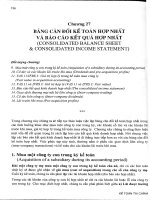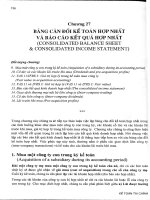Gíao trình kế toán bằng tiếng anh ch06
Bạn đang xem bản rút gọn của tài liệu. Xem và tải ngay bản đầy đủ của tài liệu tại đây (1.9 MB, 61 trang )
Chapter 6
Cost-Volume-Profit Analysis:
Additional Issues
Learning Objectives
After studying this chapter, you should be able to:
[1] Describe the essential features of a cost-volume-profit income statement.
[2] Apply basic CVP concepts.
[3] Explain the term sales mix and its effects on break-even sales.
[4] Determine sales mix when a company has limited resources.
[5] Understand how operating leverage affects profitability.
6-1
Preview of Chapter 6
Managerial Accounting
Sixth Edition
Weygandt Kimmel Kieso
6-2
Cost-Volume-Profit (CVP) Review
CVP analysis is:
6-3
The study of the effects of changes in costs and volume
on a company’s profit.
Important to profit planning.
Critical in management decisions such as:
►
determining product mix,
►
maximizing use of production facilities,
►
setting selling prices.
LO 1 Describe the essential features of a cost-volume-profit income statement.
Cost-Volume-Profit (CVP) Review
Basic Concepts
6-4
Management often wants the information reported in a
special format income statement.
CVP income statement is for internal use only:
►
Costs and expenses classified as fixed or variable.
►
Reports contribution margin as a total amount and
on a per unit basis.
LO 1 Describe the essential features of a cost-volume-profit income statement.
Cost-Volume-Profit (CVP) Review
Basic Concepts
6-5
Illustration 6-1
Basic CVP income
statement
LO 1 Describe the essential features of a cost-volume-profit income statement.
Cost-Volume-Profit (CVP) Review
Basic Concepts
Illustration 6-2
Detailed CVP
income
statement
6-6
LO 1 Describe the essential features of a cost-volume-profit income statement.
Blue Diamond, Inc. sold 20,000 units and recorded sales of $800,000
for the first quarter of 2014. In making the sales, the company
incurred the following costs and expenses.
(a) Prepare a CVP income statement for the quarter ended March 31,
2014.
(b) Compute the contribution margin per unit.
(c) Compute the contribution margin ratio.
6-7
LO 1 Describe the essential features of a cost-volume-profit income statement.
(a) Prepare a CVP income statement for the quarter ended
March 31, 2014.
6-8
LO 1
(b) Compute the contribution margin per unit.
÷ 20,000 = $40.00
÷ 20,000 = $21.60
$18.40
Per unit
6-9
LO 1
(c) Compute the contribution margin ratio.
÷ 800,000 = 46%
or,
$18.40 ÷ $40 = 46%
6-10
LO 1
Cost-Volume-Profit (CVP) Review
Basic Computations – Break-Even Analysis
Illustration: Vargo Video’s CVP income statement (Ill. 6-2)
shows that total contribution margin is $320,000, and the
company’s contribution margin per unit is $200. Contribution
margin can also be expressed in the form of the contribution
margin ratio which in the case of Vargo is 40% ($200 ÷ $500).
Illustration 6-3 and 6-4
6-11
LO 2 Apply basic CVP concepts.
Cost-Volume-Profit (CVP) Review
Basic Computations – Target Net Income
Once a company achieves break-even sales, a sales goal can be
set that will result in a target net income
Illustration: Assuming Vargo’s target net income is $250,000,
required sales in units and dollars to achieve this are:
Illustration 6-5 and 6-6
6-12
LO 2 Apply basic CVP concepts.
Cost-Volume-Profit (CVP) Review
Basic Computations – Margin of Safety
Margin of safety
cells us how far sales can drop before the company will
operate at a loss.
can be expressed in dollars or as a ratio.
Illustration: Assume Vargo’s sales are $800,000:
Illustration 6-7 and 6-8
6-13
LO 2 Apply basic CVP concepts.
Cost-Volume-Profit (CVP) Review
CVP and Changes in the Business Environment
Illustration: Original camcorder sales and cost data for Vargo
Video:
Illustration 6-9
6-14
LO 2 Apply basic CVP concepts.
Cost-Volume-Profit (CVP) Review
CVP and Changes in the Business Environment
Case I: A competitor is offering a 10% discount on the selling
price of its camcorders. Management must decide whether to
offer a similar discount.
Question: What effect will a 10% discount on selling price
($500 x 10% = $50) have on the breakeven point?
Illustration 6-10
6-15
LO 2 Apply basic CVP concepts.
Cost-Volume-Profit (CVP) Review
CVP and Changes in the Business Environment
Case II: Management invests in new robotic equipment that will
lower the amount of direct labor required to make camcorders.
Estimates are that total fixed costs will increase 30% and that
variable cost per unit will decrease 30%.
Question: What effect will the new equipment have on the
sales volume required to break even?
Illustration 6-11
6-16
LO 2 Apply basic CVP concepts.
Cost-Volume-Profit (CVP) Review
CVP and Changes in the Business Environment
Case III: Vargo’s principal supplier of raw materials has just
announced a price increase. The higher cost is expected to
increase the variable cost of camcorders by $25 per unit.
Management decides to hold the line on the selling price of the
camcorders. It plans a cost-cutting program that will save
$17,500 in fixed costs per month. Vargo is currently realizing
monthly net income of $80,000 on sales of 1,400 camcorders.
Question: What increase in units sold will be needed to
maintain the same level of net income?
6-17
LO 2 Apply basic CVP concepts.
Cost-Volume-Profit (CVP) Review
CVP and Changes in the Business Environment
Case III:
Variable cost per unit increases to $325 ($300 + $25).
Fixed costs are reduced to $182,500 ($200,000 - $17,500).
Contribution margin per unit becomes $175 ($500 - $325).
Illustration 6-12
6-18
LO 2 Apply basic CVP concepts.
Cost-Volume-Profit (CVP) Review
Review Question
Croc Catchers calculates its contribution margin to be less
than zero. Which statement is true?
a. Its fixed costs are less than the variable cost per
unit.
b. Its profits are greater than its total costs.
c.
The company should sell more units.
d. Its selling price is less than its variable costs.
6-19
LO 2 Apply basic CVP concepts.
6-20
Sales Mix
Break-Even Sales in Units
6-21
Sales mix is the relative percentage in which a
company sells its products.
If a company’s unit sales are 80% printers and 20%
computers, its sales mix is 80% to 20%.
Sales mix is important because different products
often have very different contribution margins.
LO 3 Explain the term sales mix and its effects on break-even sales.
Sales Mix
Break-Even Sales in Units
Companies can compute break-even sales for a mix of two or
more products by determining the weighted-average unit
contribution margin of all the products.
Illustration: Vargo Video sells not only camcorders but TV sets
as well. Vargo sells its two products in the following amounts:
1,500 camcorders and 500 TVs. The sales mix, expressed as a
function of total units sold, is as follows.
Illustration 6-13
6-22
LO 3 Explain the term sales mix and its effects on break-even sales.
Sales Mix
Break-Even Sales in Units
Additional information related to Vargo Video.
Illustration 6-13
Illustration 6-14
6-23
LO 3 Explain the term sales mix and its effects on break-even sales.
Sales Mix
Break-Even Sales in Units
First, determine the weighted-average contribution margin.
Illustration 6-14
Illustration 6-15
6-24
LO 3 Explain the term sales mix and its effects on break-even sales.
Sales Mix
Break-Even Sales in Units
Second, use the weighted-average unit contribution margin to
compute the break-even point in units
Illustration 6-15
Illustration 6-16
6-25
LO 3 Explain the term sales mix and its effects on break-even sales.









